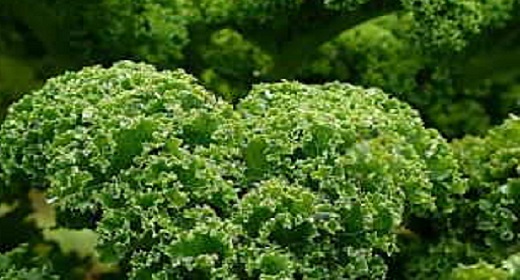by Emma: It’s called a super food. But what are the benefits of kale that make it so healthy?
This article takes a close look at this leafy green vegetable to see what it offers.
Kale is very popular among health-conscious food consumers. One reason is that it is rich in nutrients.
It has a ton of vitamins and minerals our body needs. And, it contains many antioxidants as well.
The best part is, you get them all in a natural form. No tablets or additives.
This is why it is often used for juicing and included in healthy smoothies.
Kale is often used for health and weight loss reasons.
Each cup only has around 30 calories. Plus, it is low on carbohydrates and fat as well.
Together, they make an ideal diet food.
- One unique feature of this vegetable is that it is a complete protein. It contains all 9 essential amino acids needed to form proteins in the body. This is rare as far as plant protein sources go.
- Another unique quality of this green leafy vegetable is its omega-3 content. Kale has an Omega-3 to Omega-6 ratio that’s greater than 1. That’s even rarer to see.
- It has many essential vitamins and minerals. Some of which give you more than 100% of your daily requirements.
And all this in just 1 cup of chopped kale.
Its antioxidant content, dietary fiber, protein and nutrients make kale very healthy. In fact, it is among the healthiest foods in the world.
11 Awesome Health Benefits of Kale
1. Kale is Loaded with Antioxidants for Eye Health and Fighting Vision Disorders
Kale contains lutein, which helps keep our eyes healthy.
Along with other antioxidants, it can protect against eye diseases.
Its benefits don’t seem to stop there.
At this point though, more research is needed. Only then will we know all its benefits.
Here’s what we do know…
Kale’s dark green colors come from the nutrients zeaxanthin and lutein.
These two antioxidants are proven to protect against eye diseases. Among these disorders are cataracts and macular degeneration.
Kale also has an extremely high amount of vitamin A. One cup gives you 10,302 IU. This accounts for over 200% of our recommended daily allowance of vitamin A.
Besides being essential for eye health and vision, it keeps our skin healthy. An extra bonus is that it protects us against oral and lung cancers as well.
2. It Contains High Amounts of Omega 3
Among the nutrients we get from this green vegetable is lots of omega-3.
Studies show that Omega 3 fatty acids improve mental health, fight aging and reduce inflammation.
This healthy fat is often found in marine animals. Among those high in Omega-3 are salmon, tuna and mackerel.
What’s less known is that there are a few vegetables that are also high in Omega-3. Kale is one of them.
Others include spinach, watercress, Brussels sprouts, parsley and mint.
A cup of chopped kale has 121 milligrams of omega-3 fatty acids. And, it contains 92 milligrams of Omega-6. The higher Omega-3 to Omega-6 ratio makes it even more valuable.
Kale is also sometimes compared to beef or dairy. This is true for vegans or vegetarians. The reason: it contains iron, protein, and calcium.
Obviously, kale does not have as much protein as meat. But, it does have a bit. You get 3 grams of protein per cup of chopped kale. That’s actually quite high for a vegetable.
It is likewise interesting to know that kale contains all the 9 essential amino acids. They are essential because our body needs them to from proteins. And, they’re only available through food. Our bodies don’t make them.
Having all 9 essential amino acids makes kale a complete protein. This makes it even more valuable if you’re a non-meat eater.
Lastly, kale’s anti-inflammatory capabilities are hard to beat. You can use it to prevent and even reverse arthritis, heart disease, and several autoimmune diseases.
3. Kale Lowers Cholesterol and Your Risk of Cardiovascular Disease
Fruits and vegetables are healthy for us. Many of them help with weight loss and fight heart disease.
If you’re looking for a way to lower your cholesterol, add kale to your diet. It’s a good way to improve your heart health as well.
This is according to Yonsei University in South Korea. Here, scientists found that juicing with kale helps men who have high cholesterol. It also reduced their risk of cardiovascular disease.
In the study, participants drank a glass of kale juice daily for 3 months. Results showed that their HDL cholesterol improved by 27%. LDL cholesterol dropped by 10%.
The researchers also learned that how you prepared the veggie mattered. To get the most benefits from kale’s cholesterol fighting abilities, steam it. Steaming the vegetable allows it to bind better with bile from our liver.
This allows it to be more effective in lowering cholesterol. The study also notes that steaming was even better than eating the vegetable raw. Although, eating kale raw is also very effective.
In case you want to take advantage of this green veggie, try this quick and easy kale smoothie recipe at home.
4. Kale will Give You a Fiber Boost
The American diet is low in fiber. This is why most of us don’t get enough of it on a daily basis.
Fiber helps keep your bowel movements regular. This keeps our colon healthy.
Additionally, fiber also aids in regulating blood sugar and cholesterol levels.
Research shows that high fiber diets have higher concentrations of fast circulating free fatty acids. They also produce lower triglycerides compared to diets low in fiber.
This affects your cholesterol levels. At the same, it fights obesity and helps your body’s insulin response from meals.
Together, they prevent you from experiencing problems like high blood sugar and high cholesterol.
Its high fiber content aids in regulating our blood insulin levels. It does this by controlling sugar absorption through the intestines.
Additionally, fiber also helps to make you feel full. This can lead to greater feelings of satiation. As a result, you cut down on the number of calories you consume.
All it takes is one cup of kale to get close to 3 grams of fiber into your diet.
5. It is Packed with Vitamins and Minerals
Kale is a good source of vitamins A, C and K. These are the 3 main vitamins it has plenty of.
By eating one cup of kale we get over 100% of our daily RDA requirements for these 3 vitamins.
If that’s not enough, you’ll be glad to know it is also rich in antioxidants, and anti-inflammatory compounds.
Kale’s high vitamin K content makes it valuable for fighting inflammation.
Being nutrient dense, this veggie great choice if you need to shore up on your vitamins.
A cup of kale offers the following helpful nutrients for the body:
- Vitamin A: 206% of our daily RDA.
- Calcium: 9% of our daily requirements.
- Vitamin C: 134% of our daily RDA.
- Vitamin K: 684% of our daily needs.
- Copper: 10% of our daily needs.
- Magnesium: 6% of what we need daily.
- Manganese: 26% of our daily requirements.
- Potassium: 9% of our daily needs.
In addition to those listed above, kale also offers good amounts of folate, vitamin B12 and B6, as well as iron. These nutrients are vital for red blood cell formation and preventing anemia.
6. Vitamin K in Kale Protects You from Certain Cancers and Degenerative Diseases
Vitamin K is one of the lesser known vitamins. But, it is an essential nutrient needed by the body to function properly.
Kale ranks among the highest food sources of vitamin K.
You get close to 550 mg of the vitamin in each cup serving. This gives us more than 680% of our daily recommended allowance in a small cup.
Do note that the Vitamin K that’s in kale is Vitamin K1 or phylloquinone.
This is the type of vitamin K that’s found in plants and vegetables.
In comparison, vitamin K2 is often found in soy products like tofu and natto. It is also what you get in supplement form.
Vitamin K has many of health benefits. Among them are better bone health and protection from Alzheimer’s and dementia. It also fights heart disease.
Vitamin K1 in particular, has cancer fighting properties. Among the types it helps against are lung, prostate, colon and stomach cancers.
A thing to note about this nutrient is that it is a fat soluble vitamin. This means that for the body to best absorb it, you should have it with some fats.
7. Kale has More Vitamin C than Orange
Kale is a vitamin C powerhouse.
Instead of taking an ascorbic acid tablet, consider eating a cup of chopped kale instead.
In that one cup of greens you get 80 mg of vitamin C. This makes up over 100% of what our body needs daily.
Kale actually ranks among the top foods that are highest in vitamin C. It even beats out oranges.
Other vitamin C rich vegetables include peppers, spinach, broccoli and Brussels sprouts.
Vitamin C boosts your immune system so don’t get sick.
It is also involved in collagen production.
Collagen helps keep skin healthy. It is needed by our bones, connective tissues, blood vessels and organs as well.
8. Its Anti-Oxidative Properties Make Kale Anti-Inflammatory
Antioxidants protect our body’s cells from oxidative damage caused by free radicals.
Oxidative damage happens when the body isn’t able to counter free radicals.
As a result, oxidative stress harms us by causing illness and diseases. Often, these problems develop over the long term.
Some of which include cancer, Parkinson’s and Alzheimer’s disease. Oxidative stress can also lead to heart disease and inflammation.
Here’s where antioxidants come in.
Antioxidants are molecules in our cells. They work by preventing oxidative stress from happening. Their job is to fight against the free radicals and get them under control.
Research tells us that kale contains antioxidants like kaempferol, quercetin and flavonoids. All three are helpful in fighting off free radicals from harming the body.
If you want to get the most out of kale’s antioxidants, eat it raw.
This according to the University of Agriculture in Krakow, Poland. Researchers ran a test comparing the nutrient value of raw and cooked kale. Results show that cooking significantly lowers the antioxidant compounds in the vegetable.
Cooking caused a loss of around 5% of beta-carotene. Bigger losses came for polyphenols (56%), and vitamin C (89%). Plus, there was a 38% decrease in the antioxidant activity after cooking.
9. Kale Can Help You Lose Weight in a Healthy Way
To eat healthy, whole foods are the best choice. This applies to our meals and snacks. It also becomes more important for anyone trying to lose weight.
But, as we know, it isn’t always possible to eat healthy.
Here’s where kale can help.
This green leafy vegetable is high in fiber and low in fat. These features make it useful for anyone going on a diet.
Science shows us that fruits and vegetable are a crucial part of any weight loss diet. And kale is no exception.
Besides being high in fiber and low in fat, kale has two other properties to help you lose weight. It is low in calories and a complete protein.
Note that you should always consult your doctor before making any change in your diet.
10. Kale is Cheap and Abundant at the Grocery Store
Kale, due to its increasing popularity has grown in use around the country.
The vegetable is quite cheap at around 60 cents per cup. So, with a few dollars you can have enough kale to feed your family for several days.
This is like getting a nutrient heavyweight at a basement bargain price.
It contains Omega-3 fats. Plus, it is high in vitamins A, C and K. Kale is also rich in minerals including calcium, copper, magnesium, potassium and others.
All this in a low calorie, high fiber veggie.
Altogether, it offers great value for your money.
Stored correctly, kale will last at least a few days. This lets take your time and try new recipes.
11. It is Easy to Mix into Recipes and Meals
Kale is not only nutritious, but also has many different applications to meals and diet plans.
You can sautee it, stir fry, fry, bake, and prepare it in many other ways.
You can also mix it into your smoothies, salads and casseroles. Or, serve it as side dish.
It’s so versatile that you can make it as a stand-alone dish or with other ingredients.
Its high nutrient content also lets you fortify other foods using it. For example, mixing it with carbs or protein rich foods gives you a complete balanced meal.
Choosing, Storing and Using Kale
How to Choose Kale
When it comes to choosing kale from the produce shelf, using our sense of sight and touch are what we need most.
- Look for kale that has a deep green color.
- Avoid those whose leaves show signs of browning or are starting to wilt. We want to see leaves that are firm not soft or look weak.
- Also check for any holes that may be signs that insects have gone through them.
Extra Tips:
Kale does have a bit of a bitter flavor.
If you don’t like its flavor, or want to keep its taste subtle, choose the bunches with smaller leaves. These will be easier to eat since they have a milder taste compared to those with larger leaves.
Kale is available during every season of the year. But, the vegetable has a sweeter taste during the cooler months.
So, if you prefer the sweeter flavor, buy them around winter to early spring. This will be the best times to do so.
Like other vegetables, you should store kale in cool temperatures.
It is a close relative of the cabbage and broccoli. And, it belongs to the cruciferous vegetable family.
They wilt and become less fresh faster under warm temperatures. This means that they belong in the refrigerator once you get home.
In your fridge…
- Place them in a bag and store away.
- Kale will store for a few days, but less than a week even when refrigerated.
- If you prefer kale with mild flavor, try not to store it too long before eating. The longer it stays stored the stronger the bitter taste.
Using Kale in Your Meals
Incorporating Kale into Your Meal Plans
Kale is one of the easier foods to include in our diets.
You can add them to salads, cook them with food or serve as a side dish.
Athletes and health enthusiasts include kale in their juices and smoothies. This is also something dieters do.
Below are two of the most popular ways of extracting kale’s nutrients.
- Juicing. With juicing, you try to squeeze the juice along with the nutrients out of the greens.
- Blending. Blending meanwhile, uses a blender or mixer. This chops up the kale, making it into a much smoother consistency.
As mentioned earlier, to get the most nutritional benefits from kale, eat them raw. Studies show that cooking significantly lowers its vitamin, mineral and antioxidant content.
Conclusion
Go ahead, get to the grocery store and grab a few handfuls of kale.
They’re great for your health. And, your body will love you for it.
They’re one of the most nutrition dense foods available.
What’s even better is that they’re very easy to include into your meals. This is true for lunch, breakfast, snack time or dinner.



























































